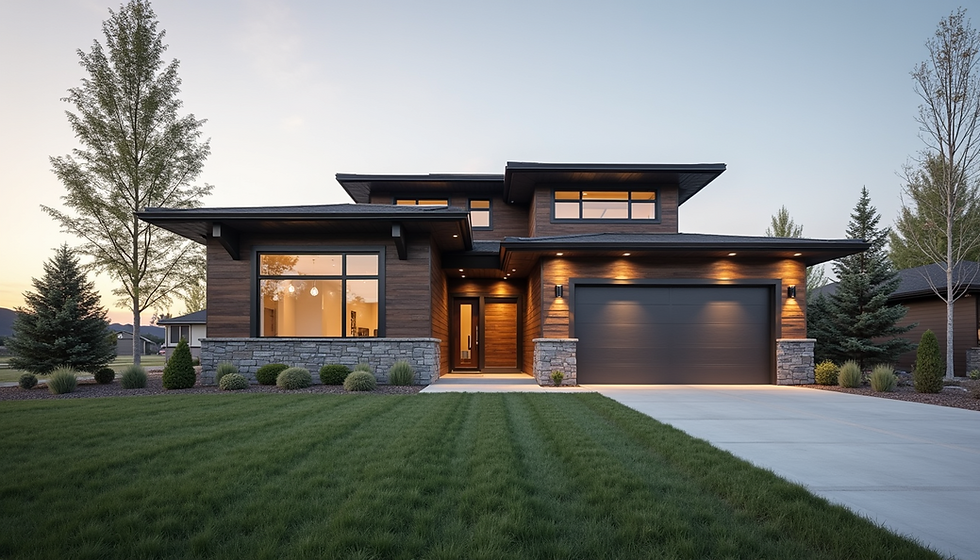Stronghold ICF Foam Blocks vs Traditional Wood Form Stem Walls What Home Buyers Should Know
- Adam Haines
- Jun 8
- 4 min read
Building or buying a new home is an exciting journey, but it comes with important decisions. One of the biggest choices you face is selecting the right foundation system. Among the options available, Stronghold ICF (Insulated Concrete Forms) foam blocks and traditional wood form stem walls are two popular choices. Each has its own pros and cons that can affect your home's effectiveness, sustainability, and overall comfort.
In this blog post, we will break down the differences between Stronghold ICF foam blocks and traditional wood form stem walls. Our goal is to help home buyers make informed choices by highlighting their respective benefits.
What Are Stronghold ICF Foam Blocks?
Stronghold ICF foam blocks represent a modern approach to home construction that prioritizes energy efficiency. Made primarily from expanded polystyrene (EPS) foam, these blocks are stacked to form walls which are then filled with concrete, resulting in a robust and insulated wall system.
One standout feature of Stronghold ICF is its impressive R-value ratings, which typically range from 20 to 25. A higher R-value means better insulation, translating into significant energy savings. For instance, homes utilizing Stronghold ICF can reduce heating and cooling costs by 30% or more compared to traditional methods. Additionally, these blocks offer exceptional soundproofing, enhanced durability against weather extremes, and a greater resistance to pests like termites, resulting in a safer and more comfortable living environment.
Understanding Traditional Wood Form Stem Walls
Traditional wood form stem walls have been a foundational method in home construction for years. This approach involves using wooden forms to shape concrete foundations. While trusted, it has its set of advantages and disadvantages.
The most appealing aspect of wood form stem walls is their lower upfront cost. Wood tends to be less expensive than ICF materials, making it an attractive option for those on a budget. An average home built with wood forms can cost 10-15% less in initial expenses compared to ICF structures. Additionally, wood forms allow for greater customization on-site, which can be beneficial for unique design requirements.
However, wood is prone to moisture issues, termites, and other pests, which can compromise the building’s integrity. Homeowners using wood stem walls may face repairs due to rot or insect damage within a few years, adding hidden costs that could exceed initial savings.
Comparing R-Value Ratings
R-value is a critical metric in insulation. Stronghold ICF typically holds R-values between 20 and 25, which means homes built with this system offer superior insulation. This level of thermal resistance helps maintain stable indoor temperatures, leading to reduced energy bills and a more comfortable living environment.
In contrast, traditional wood form stem walls, even when properly insulated, generally achieve R-values closer to 10 to 15. As a result, homeowners may spend significantly more on energy—often increasing heating and cooling costs by 15-20% over time. Especially in states like Washington, where winters can be harsh, choosing an energy-efficient system like Stronghold ICF can have a substantial impact on energy consumption and costs.
Construction Time and Convenience
Time is of the essence in construction. Stronghold ICF systems can lead to faster build times compared to traditional wood form stem walls. The lightweight and easy-to-handle foam blocks help builders erect walls significantly quicker, which can shorten overall project timelines by up to 20%. For home buyers eager to move into their new space, this can be a crucial advantage.

Conversely, traditional wood stem walls often involve a more labor-intensive process. The need for precise measurements and numerous wooden components can slow down the construction process, leading to longer waiting periods for those keen to settle into their new homes.
Environmental Impact
The environment is a growing concern in today’s world, and the choice of construction materials plays a big role in sustainability. Stronghold ICF foam blocks are often viewed as more eco-friendly due to their energy efficiency and minimal waste produced during construction. They can contribute to reduced energy consumption throughout the lifetime of the home, appealing to buyers who prioritize sustainability.
On the flip side, although traditional wood form stem walls are made from renewable resources, they can lead to deforestation and heightened energy usage for heating and cooling. Furthermore, if wood structures require frequent repairs due to damage, this can increase waste over time.
Costs and Long-Term Savings
Initial costs can be misleading. While Stronghold ICF foam blocks may present a higher upfront investment, they provide significant long-term savings. Lower energy bills and reduced maintenance costs can lead to thousands of dollars saved over the life of the home.
In contrast, although traditional wood form stem walls might appear more cost-effective at first glance, hidden costs may accumulate from pest damage and higher energy bills. Home buyers should weigh both short-term costs and potential long-term savings when considering their options.
Making Your Decision
Choosing between Stronghold ICF foam blocks and traditional wood form stem walls depends on your priorities, budget, and values.
Stronghold ICF offers remarkable energy efficiency, durability, and faster construction—benefits that resonate with many modern home buyers. However, traditional wood framing has its appeal for those watching their immediate budgets, though it may come with risks that could impact long-term living conditions.
As you embark on your home-building journey, take the time to consider these factors carefully. Consulting with professionals who can offer tailored insights will help you make decisions that align with your vision for a comfortable, energy-efficient living space. Ultimately, the right choice can put you on the path to a happy and sustainable home.



Commentaires